
The Geheime Staatspolizei, abbreviated Gestapo, was the official secret police of Nazi Germany and in German-occupied Europe.

Reinhard Tristan Eugen Heydrich was a high-ranking German SS and police official during the Nazi era and a principal architect of the Holocaust.
Sicherheitsdienst, full title Sicherheitsdienst des Reichsführers-SS, or SD, was the intelligence agency of the SS and the Nazi Party in Nazi Germany. Established in 1931, the SD was the first Nazi intelligence organization and the Gestapo was considered its sister organization through the integration of SS members and operational procedures. The SD was administered as an independent SS office between 1933 and 1939. That year, the SD was transferred over to the Reich Security Main Office, as one of its seven departments. Its first director, Reinhard Heydrich, intended for the SD to bring every single individual within the Third Reich's reach under "continuous supervision".

The Venlo incident, was a covert operation carried out by the German Nazi Party's Sicherheitsdienst (SD) on 9 November 1939, which resulted in the capture of two British Secret Intelligence Service agents five metres (16 ft) from the German border, on the outskirts of the Dutch city of Venlo.
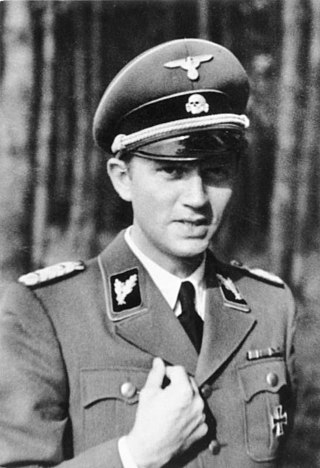
Walter Friedrich Schellenberg was a German SS functionary during the Nazi era. He rose through the ranks of the SS, becoming one of the highest ranking men in the Sicherheitsdienst (SD) and eventually assumed the position as head of foreign intelligence for Nazi Germany following the abolition of the Abwehr in 1944.

The Reich Security Main Office was an organization under Heinrich Himmler in his dual capacity as Chef der Deutschen Polizei and Reichsführer-SS, the head of the Nazi Party's Schutzstaffel (SS). The organization's stated duty was to fight all "enemies of the Reich" inside and outside the borders of Nazi Germany.

Heinrich Müller was a high-ranking German Schutzstaffel (SS) and police official during the Nazi era. For most of World War II in Europe, he was the chief of the Gestapo, the secret state police of Nazi Germany. Müller was central in the planning and execution of the Holocaust and attended the January 1942 Wannsee Conference, which formalised plans for deportation and genocide of all Jews in German-occupied Europe—The "Final Solution to the Jewish Question". He was known as "Gestapo Müller" to distinguish him from another SS general named Heinrich Müller.
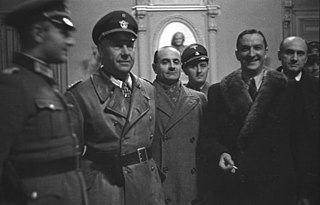
The Sicherheitspolizei, often abbreviated as SiPo, was a term used in Germany for security police. In the Nazi era, it referred to the state political and criminal investigation security agencies. It was made up by the combined forces of the Gestapo and the Kriminalpolizei between 1936 and 1939. As a formal agency, the SiPo was incorporated into the Reich Security Main Office (RSHA) in 1939, but the term continued to be used informally until the end of World War II in Europe.
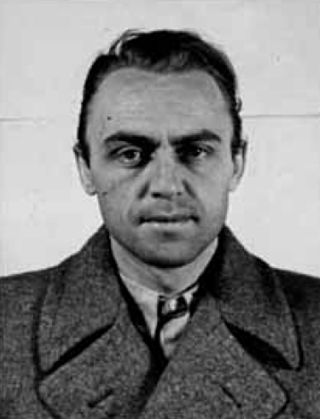
Alfred Helmut Naujocks, alias Hans Müller, Alfred Bonsen, and Rudolf Möbert, was a German SS functionary during the Third Reich. He took part in the staged Gleiwitz incident, a false flag intended to provide the justification for the attack on Poland by Nazi Germany, which ultimately culminated in starting World War II.

Captain Sigismund Payne Best OBE was a British Secret Intelligence Service agent during the First and Second World Wars. He was captured by German Gestapo and Sicherheitsdienst (SD) men on 9 November 1939 in the Venlo Incident.

Nazi exploitation is a subgenre of exploitation film and sexploitation film that involves Nazis committing sex crimes, often as camp or prison overseers during World War II. Most follow the women in prison formula, only relocated to a concentration camp, extermination camp, or Nazi brothel, and with an added emphasis on sadism, gore, and degradation. The most infamous and influential title is a Canadian production, Ilsa, She Wolf of the SS (1974). Its surprise success and that of Salon Kitty and The Night Porter led European filmmakers, mostly in Italy, to produce similar films, with just over a dozen being released over the next few years. Globally exported to both cinema and VHS, the films were critically attacked and heavily censored, and the sub-genre all but vanished by the end of the seventies.

Private Schulz is a 1981 BBC television comedy drama serial set mostly in Germany, during and immediately after World War II. It stars Michael Elphick in the title role and Ian Richardson playing various parts. Other notable actors included Tony Caunter, Billie Whitelaw, Billy Murray and Mark Wingett. It was shown on Masterpiece Theatre in the US.

Josef Albert Meisinger, also known as the "Butcher of Warsaw", was an SS functionary in Nazi Germany. He held a position in the Gestapo and was a member of the Nazi Party. During the early phases of World War II Meisinger served as commander of Einsatzgruppe IV in Poland. From 1941 to 1945 he worked as liaison for the Gestapo at the German embassy in Tokyo. He was arrested in Japan in 1945, convicted of war crimes and was executed in Warsaw, Poland.

Salon Kitty is a 1976 erotic-war-drama film directed by Tinto Brass. The film was co-produced by Italy, France and West Germany. It is based on the novel of the same name by Peter Norden, covering the real life events of the Salon Kitty operation, under which the Sicherheitsdienst took over an expensive brothel in Berlin, had the place wire tapped, and replaced all the prostitutes with trained spies, in order to gather information on various members of the Nazi party and foreign dignitaries.

Franz Josef Huber was an SS functionary who was a police and security service official in both the Weimar Republic and Nazi Germany. Huber joined the Nazi Party in 1937 and worked closely with Gestapo chief Heinrich Müller. After the German annexation of Austria in 1938, Huber was posted to Vienna, where he was appointed chief of the Security Police (SiPo) and Gestapo for Vienna, the "Lower Danube" and "Upper Danube" regions. He was responsible for mass deportations of Jews from the area. After the war ended, Huber never served any prison time. He was employed by the West German Federal Intelligence Service from 1955–64. He died in Munich in 1975.
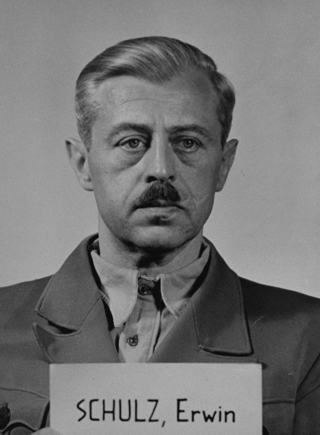
Erwin Wilhelm Schulz was a German member of the Gestapo and the SS in Nazi Germany. He was the leader of Einsatzkommando 5, part of Einsatzgruppe C, which was attached to the Army Group South during the planned invasion of Soviet Union in 1941, and operated in the occupied territories of south-eastern Poland and Ukrainian SSR committing mass killings of civilian population, mostly men of Jewish ethnicity, under the command of SS-Brigadeführer Otto Rasch.

Adolf Hitler, the dictator of Nazi Germany, initiated World War II in Europe with the invasion of Poland in September 1939 and was central to the Holocaust. He was hated by his persecuted enemies and even by some of his own countrymen. Although attempts were made to assassinate him, none were successful. Hitler had numerous bodyguard units over the years which provided security.
Georg Herbert Mehlhorn was an SS Oberführer, Nazi legal expert, and Gestapo official. Mehlhorn was involved in the camouflage of the mass graves of the Jewish victims in the forest of the Chełmno extermination camp. He operated gas wagons at the Chełmno camp to murder the sick Jewish prisoners who were sent from the Wartheland ghettoes. He was also a director of Stiftung Nordhav, a front organization of the Sicherheitsdienst founded in 1939 by Reinhard Heydrich, one of the main architects of the Holocaust. He was the mentor of SS-Brigadeführer Walter Schellenberg while at the SS-Hauptamt.

Einsatzgruppe Serbia, initially named Einsatzgruppe Yugoslavia, was a German Schutzstaffel (SS) grouping in the German-occupied territory of Serbia during World War II. Directly responsible to the Reich Security Main Office in Berlin, EG Serbia consisted of representatives of the various offices of the RSHA, particularly Amt IV – the Gestapo, Amt V – the Kriminalpolizei, and Amt VI – the Ausland-Sicherheitsdienst. It also controlled the 64th Reserve Police Battalion of the Ordnungspolizei. While formally responsible to the Military Commander in Serbia via the head of the administrative branch of the military headquarters of the occupied territory, the chief of EG Serbia reported directly to his superiors in Berlin.
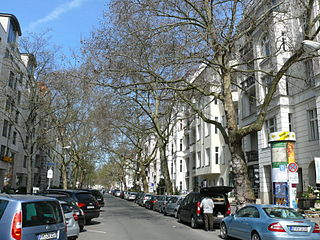
Giesebrechtstraße is a residential street that runs between Wilmersdorfer Straße and Kurfürstendamm, roughly a 1 kilometre (0.62 mi) north of Preußenpark, in the western Berlin district of Charlottenburg. It was built in the early 1900s in connection with the development of Kurfürstendamm. It does not branch off at right angles like most of the side streets of Kurfürstendamm, but at an obtuse angle of about 120 degrees.






















